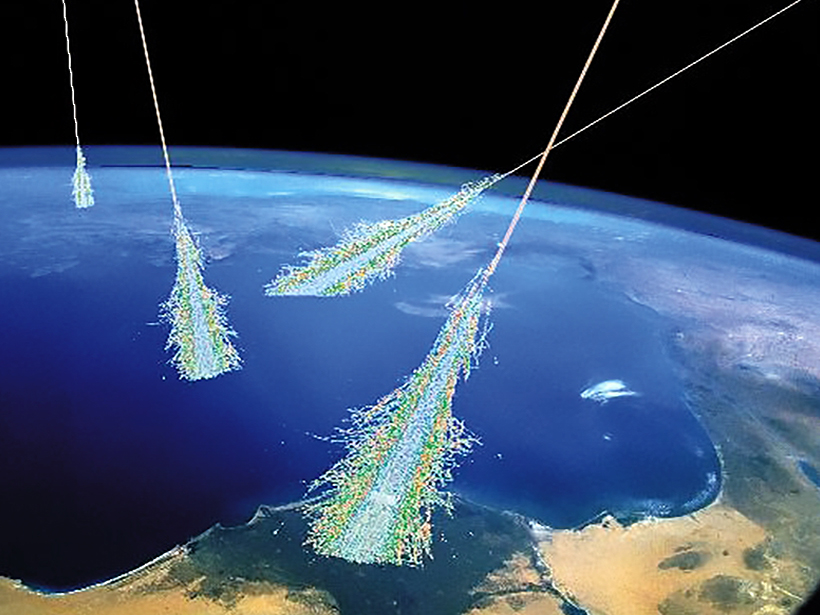Investigators can use the quantities of muons detected underground to determine the density of the overlying region.
Pumping carbon dioxide (CO2) from power plants or other sources underground could reduce emissions of the greenhouse gas to the atmosphere, but it won’t do much to stave off global warming if the subterranean repositories leak. A team of researchers has now devised a way to test the integrity of underground CO2 storage by using muons—subatomic particles that are heavy cousins of electrons—and is getting ready to try out the new technique.
Alain Bonneville, a geophysicist at the Pacific Northwest National Laboratory (PNNL) in Richland, Wash., and his colleagues will drill a borehole horizontally beneath a yet to be chosen carbon sequestration repository (after a previous site in Illinois fell through) and place muon detectors inside the tube. Collisions between cosmic rays and particles in Earth’s atmosphere spray bursts of subatomic particles toward Earth’s surface, some of which are muons that can penetrate deep into the planet or even all the way through it. Because more dense matter stops more muons, investigators can use the quantities of muons detected underground to determine the density of the overlying region through which the muons passed.
Bonneville and his colleagues designed and are currently testing a new type of muon detector that will fit more easily into the borehole than conventional drift tube muon detectors. The researchers shrank their detectors by using plastic components as well as optical fibers to illuminate the path a muon takes through the device.
Detecting Density
“You can look at the places where the density changes. As the carbon dioxide plume moves, you can see if there’s a problem such as a leak.”
In the types of repositories that Bonneville and his team plan on studying, porous sandstone makes up about 80% of the reservoirs, and salty brine filling the rock’s pores makes up the other 20%. When injected into the reservoir, atmospheric carbon dioxide displaces that brine, so the proportions will become more like 80% sandstone, 10% brine, and 10% carbon dioxide. Because carbon dioxide is less dense than brine, it lowers the density of the areas it enters, allowing more muons to pass through. From the counts in their muon detectors, the researchers will tell where the reservoir’s density is low, signaling that carbon dioxide is present.
“You can look at the places where the density changes. As the carbon dioxide plume moves, you can see if there’s a problem such as a leak,” said Bonneville, who reported on the new technique in a poster presentation during the American Geophysical Union’s 2015 Fall Meeting in San Francisco, Calif.
Because leaks are most likely at the margins of the reservoir, an abundance of muons detected along an edge will likely signify that a leak there is letting carbon dioxide out of the reservoir, Bonneville explained.
Beyond Carbon Leaks
Other forms of radiation, such as gamma rays or X-rays, which are more commonly used for probing inside dense materials, allow scientists to see only up to a few meters into the Earth, said PNNL particle physicist Richard Kouzes, who is on the team developing the new muon detectors and leak-detecting technique. However, muons can reveal interior details as much as a few thousand meters beneath the surface.
In addition to potentially finding carbon leaks, muons could prove useful as probes for other sorts of applications, said Charlotte Rowe, a geophysicist at the Los Alamos National Laboratory in Los Alamos, N.M., who is not involved with the leak detection research. Researchers are exploring using muons to image the interior of ancient pyramids, evaluate the structural integrity and the seismic retrofitting of old buildings, and detect in real time and determine later the characteristics of seismic events that went unrecorded by seismometers.
—Cody Sullivan, Writer Intern
Citation: Sullivan, C. (2015), Trying out muons to detect carbon leaks, Eos, 96, doi:10.1029/2015EO042113. Published on 17 December 2015.
Correction, 23 December 2015: An earlier version of this article incorrectly identified the location of a carbon sequestration repository that had fallen through as the place for testing the muon-based leak detector. This article has been updated with the information that the repository was located in Illinois.
Text © 2015. The authors. CC BY-NC 3.0
Except where otherwise noted, images are subject to copyright. Any reuse without express permission from the copyright owner is prohibited.

